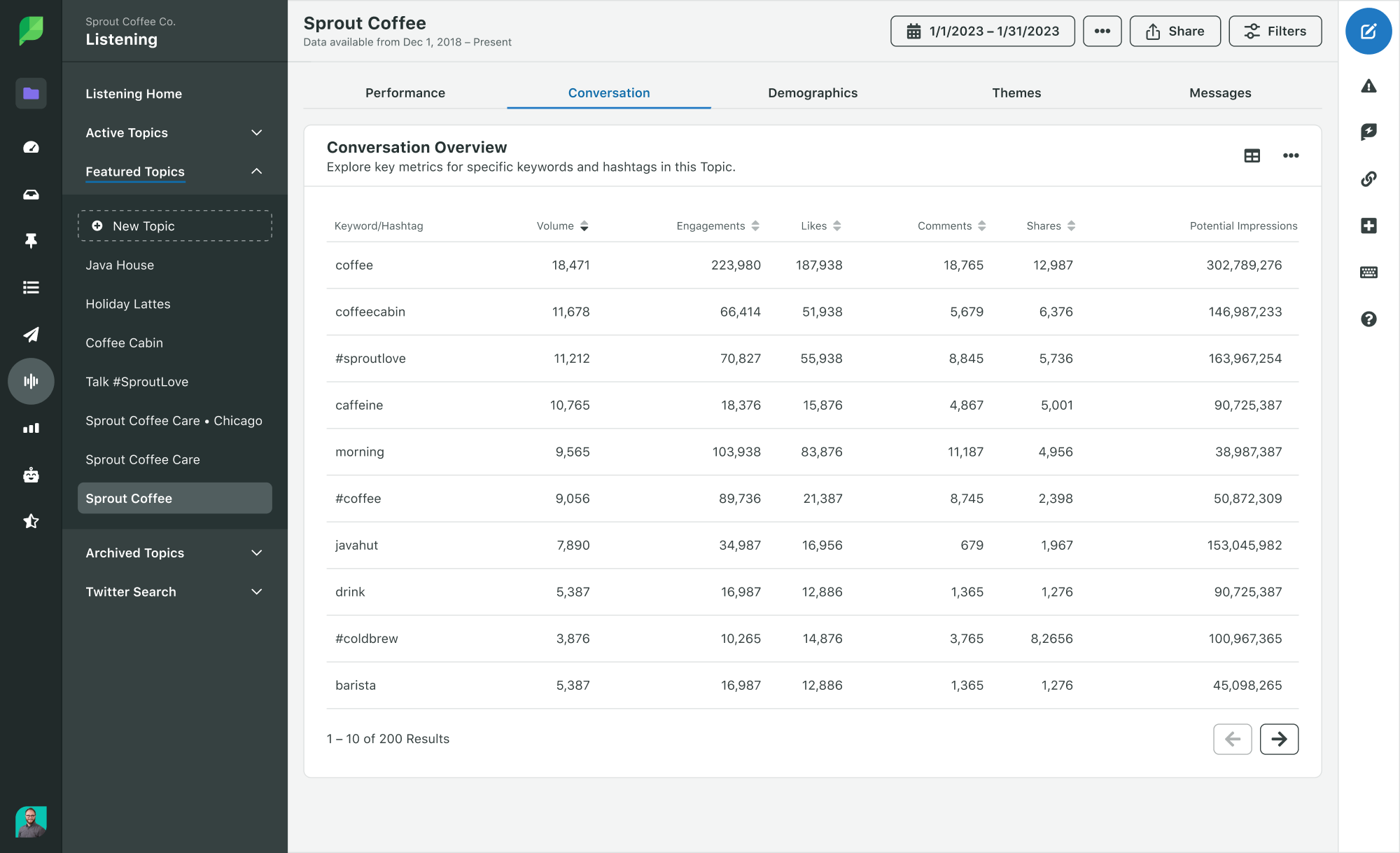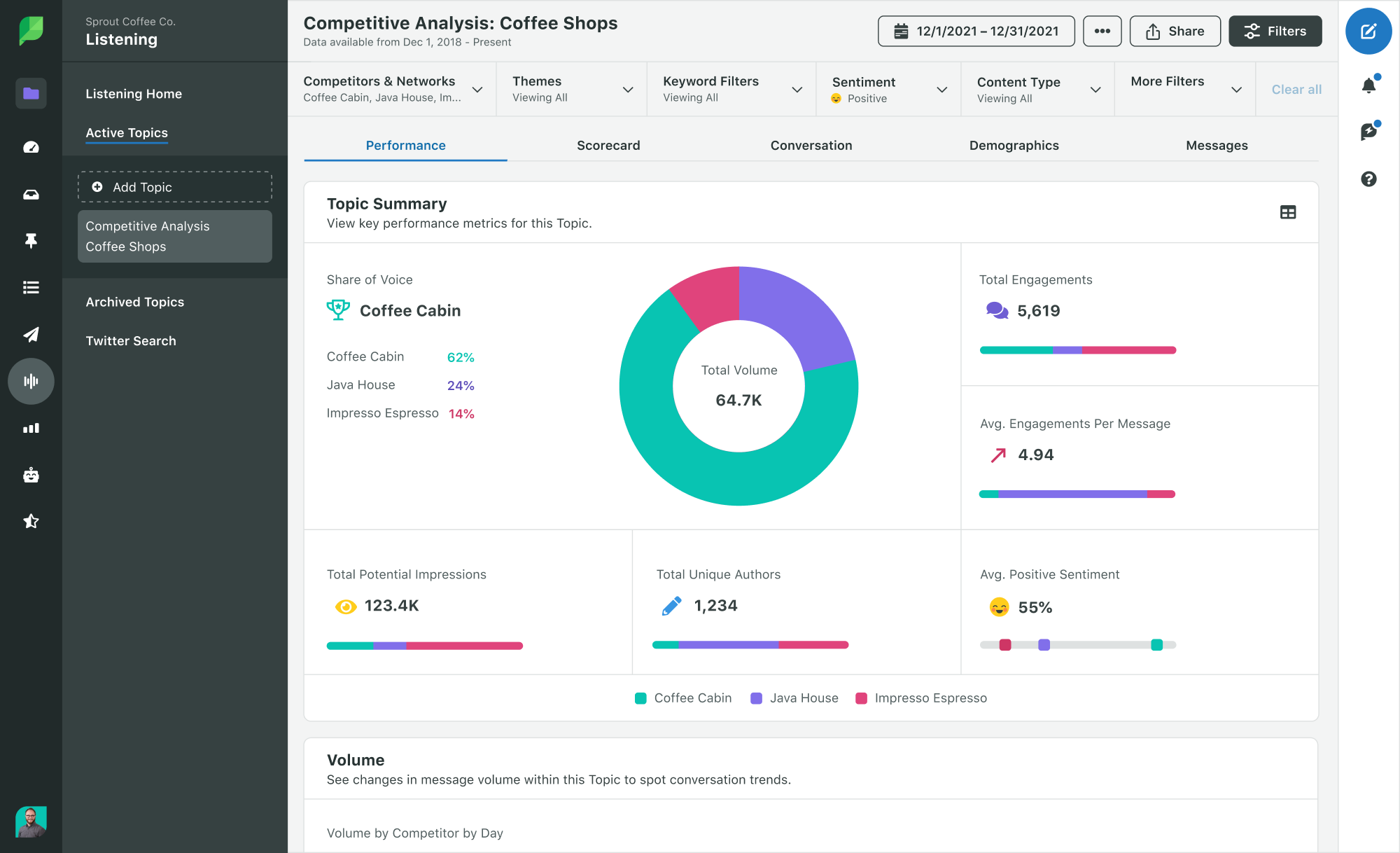The importance of your marketing messaging can’t be overstated.
Because what you say (and how to say it) to your customers ultimately defines your brand.
That said, businesses need to make sure that their messaging is flexible enough to evolve.
Customers change. Industries pivot. By having a constant pulse on which messages perform best to your audience, your marketing is more likely to land with customers over time.
And social media is arguably the best channel for doing exactly that.
In this guide, we’ll highlight how to use social listening for marketing messaging to make sure your campaigns resonate in 2021 and beyond.
Why brands should regularly refresh their marketing messaging
Chances are you probably feel confident about what your customers want to hear from you.
That said, how you “feel” doesn’t tell the whole story.
Below are some key reasons why assessing and updating your marketing messaging’s effectiveness should be a top priority.
Customer behavior and expectations aren’t static
Modern marketing is about so much more than pushing products.
Consider how younger consumers are increasingly interested in companies that market around activism and social justice. Whereas brands of the past may have been wary of “choosing sides” or addressing seemingly controversial issues, taking a stand has become much more common.
Again, customers change. So do their values, needs and desires. Brands need to keep up with those expectations.
Avoid being perceived as out of touch
Rolling out the same campaigns and promotions with identical marketing messages is lazy at best.
However, doing so could also damage your brand’s reputation.
Heck, look no further than how hard some companies had to pivot during COVID-19. The pandemic served as a prime opportunity for brands to show their humanity. On the flip side, companies that ignored it were rightfully criticized for being tone-deaf.
Another prime example is marketing during a recession. Messages centered around affordability and empathy are likely to land whereas messaging focused on luxury might be considered out of touch.
Uncover new opportunities to optimize your marketing campaigns
If nothing else, refreshing your marketing messaging represents an opportunity to figure out which campaigns are working and which aren’t.
And you won’t know until you look at your data.
Although there are plenty of sources to choose from, social listening data is invaluable for fine-tuning your messaging. Why? Because listening data is:
- Specific and organic (straight from the mouths of your customers and competitors alike)
- Up-to-date and timely (given that it comes directly from social media)
- Sourced from people beyond your customers (think: leads, prospects, competitors)
How to use social listening to improve your marketing messaging
Now, let’s look at what social listening can do to uncover opportunities to optimize your messaging (and what doing so looks like using Sprout).
Start with sentiment analysis to assess your current brand health
You need to start with some sort of baseline of how companies feel about both you and your marketing messages.
This is where conducting sentiment analysis comes in handy. Using context from comments, questions and conversations via social media, tools like Sprout can translate your mentions into messaging data.
For example, sentiment analysis can clue you in on whether people largely feel positively, negatively or indifferent about your brand based on how they talk about it.

Brands heading into 2021 may want to pay particular attention to customer sentiment prior to and during COVID-19 to see how the pandemic had an impact (if at all).
Dig into messages from your fans, followers and customers
Once you have a big-picture understanding of sentiment, it’s time to dig into specific conversations.
Social listening can help you identify keywords and hashtags associated with marketing as they appeared through your campaigns. For example, tools like Sprout can help you answer the following questions:
- What are people saying about specific products or promotions?
- Did people talk about your biggest marketing pushes? Did they land?
- Which accounts (think: influencers, collaborators, press mentions) resulted in the most buzz for your business?
- Were most conversations about your products or related to trends and news?
- What were your top-performing social messages for the year?
And finding those answers means looking at your analytics and relevant keyword terms used by your audience. Here’s what that data looks like with our tool:

Based on these answers, you can uncover the common threads between your best campaigns. This includes content themes and, of course, marketing messages.
Analyze conversations from your competitors and industry at large
Competitive analysis is a huge piece of figuring out your messaging. You obviously don’t want to parrot your competitors.
This is yet again where social listening comes in handy. For example, you can use listening data to identify trending topics based on conversations within your industry. This includes conversations among your competitors and their customers. Based on their wins (or struggles), you can tap into new messaging opportunities or at least know which types of messages to steer clear of.
Beyond specific messages, you can also analyze who has the greatest share of voice among your competitors and determine who’s marketing messaging reigns supreme.

What other data can you use to improve marketing messaging?
Keep in mind that social data certainly isn’t the be-all, end-all of data to level up your messaging. Below are some other sources of insight and inspiration.
Look at your marketing analytics beyond social
From SEO to email marketing campaigns and beyond, your marketing analytics can help reinforce what you already know about your marketing messages.
For example, let’s say your website drove most of its search traffic from queries related to “longest-landing [product]” or “safest [product].” If so, you’d be right to double-down on messaging related to safety and longevity.
Or let’s say your highest-converting email campaigns were related to steep discounts. This signals the importance of emphasizing affordability. Again, your analytics can clue you in (see Sendinblue’s dashboard, for reference).

Look at your ratings and review data
Anywhere you can source real-world comments from customers is a plus for messaging optimization. Reviews are no exception. For example, check out how IT Cosmetics‘ review aggregator breaks down the positives and negatives of any given product.

Much like your social mentions, review comments can highlight specific product features to reinforce throughout your marketing messages.
Gather firsthand insights from folks in customer-facing roles
As a side note, make a point to include people outside of your marketing department to give some additional context to your messaging.
For example, people in customer support roles are invaluable given the fact that they, you know, actually talk to customers. The same rings true for sales personnel that manage frequent objections and questions.
How to use your data to craft marketing messages and campaigns
To wrap things up, let’s look at the “next steps” required once you’ve gathered your data and you’re ready to optimize your messaging.
Talk about your data with the rest of your team
Piggybacking on the last point above, marketing messaging is a crucial component of your business that needs to be discussed with multiple decision-makers. Making any sweeping changes to your messaging shouldn’t be the sole decision of one person. Meeting with others to hash out your data is key to deciding on which campaigns to consider.
Update your customer personas to reflect your new messaging
Granted that you’ve already produced your company’s social media personas, make sure to update yours accordingly as your messaging changes. In short, your personas from 2015 shouldn’t look the same as your personas from 2021.

Brainstorm and test new campaigns
Finally, it’s time to start putting your new messaging to the test.
If you want some inspiration on which types of messages traditionally resonate with consumers, make sure to check out our guide to developing your marketing messaging.
And once you start rolling out those new campaigns, you can start tracking via social media testing prior to scaling up elsewhere. Here you can see whether or not your new messaging performs better in terms of engagement, meanwhile keeping track of your data via tools like Sprout Social.

Are you using your social listening data to boost your marketing messaging?
Social listening data is invaluable for marketers looking to solidify their marketing messaging.
And there’s no better time to do so than now! By having a pulse on trends and conversations related to your business, you can more easily boost your messaging and never run the risk of being out of touch.
Speaking of trends, make sure you check out the Sprout Social Index to see exactly how today’s brands are leveraging their social data.
This post How to use social listening to improve your marketing messaging originally appeared on Sprout Social.
from Sprout Social https://ift.tt/3qGHVYs
via IFTTT
No comments:
Post a Comment